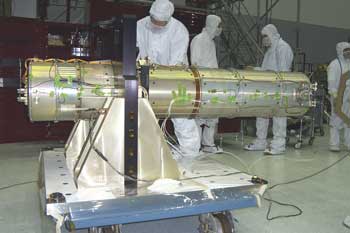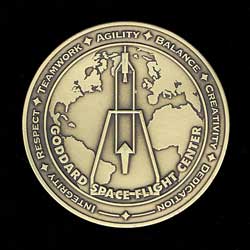Mullard Space Science Laboratory
P R E S S R E L E A S E
22 April 2005
REF: SWIFT2005-2
Local scientists observe birth of black holes
Two violent cosmic explosions on the far side of the Universe have just been detected by a telescope built at University College London's Mullard Space Science Laboratory between Dorking and Guildford. The explosions are the biggest in the Universe and are known as gamma-ray bursts. They were unleashed billions of years before the Sun and the Earth were created and the light has been travelling through space ever since. Finally the light reached the Ultra-Violet and Optical Telescope (UVOT), in orbit around the Earth on a NASA spacecraft called Swift.

Swift UVOT.
These observations represent the first direct 'distance'‚ measurements of gamma ray bursts by the Swift spacecraft since its launch in November 2004. Eventually these distance measurements will become routine, allowing scientists to create a map of the Universe to understand where, when and how these brilliant, fleeting bursts of light are created.
"Every burst is a little different, and when we add them all up we will begin to see the full picture," said Professor Keith Mason, the UVOT lead at Mullard Space Science Laboratory.
Gamma-ray bursts are the most powerful explosions known in the Universe and are thought to signal the birth of a black hole. These objects are thought to be formed either by the explosion of a massive star, or through the collision of massive stars. Amazingly, several bursts appear each day as seen from the Earth. However, they are difficult to detect and study because they occur randomly at any point in the sky and the main flash of light only lasts from a fraction of a second to about a minute. The Swift satellite must repoint itself quickly to catch them.
"The Swift satellite is specifically designed to rapidly repoint at bursts when they go off" said Professor Keith Mason. "These were the first of hopefully many bursts that will be studied very closely with the Ultra-Violet and Optical telescope." he added.
The two bursts detected are estimated to be about 10.5 billion and 11.6 billion light years away. The second burst was so bright that it could have been seen through a backyard telescope.
The observations were made around the same time that scientists at MSSL were receiving awards from NASA in recognition of their outstanding work on the Swift mission. Several members of staff across the engineering and research groups at MSSL each received a bronze medal and certificate signed by the director of NASA's Goddard Space Flight Centre in a special award ceremony.

NASA medals presented to MSSL's Swift team.
"It is fantastic that UK scientists play such a major role in space research and receiving this award from NASA marks just the start of our voyage of discovery with Swift." said Professor Keith Mason. Professor Mason, currently the Director of MSSL, is soon to become the Chief Executive of the Particle Physics and Astronomy Research Council, which funds the majority of Space Science research in the UK.
Notes to Editors
More information about each of the Swift-detected gamma-ray bursts, updated every five minutes, is available at http://grb.sonoma.edu
MSSL website http://www.mssl.ucl.ac.uk
NASA Swift website http://swift.gsfc.nasa.gov/docs/swift/swiftsc.html
UK Swift Data Centre http://www.swift.ac.uk/
UK Role in Swift
Swift is a NASA mission with a strong contribution from UK scientists. Major elements of two of the telescopes on the satellite (the X-ray telescope and the UV/Optical telescope), have been provided by UK scientists with funding from the Particle Physics and Astronomy Research Council. PPARC is the UK‚s strategic science investment agency. It funds research, education and public understanding in four broad areas of science - particle physics, astronomy, cosmology and space science.
Mullard Space Science Laboratory, UCL
The major part of the UV/Optical Telescope was constructed at MSSL using designs and expertise from the Optical Monitor on the XMM-Newton spacecraft which was launched in 1999.
MSSL is situated in Holmbury St Mary between Dorking and Guildford, and is the Space and Climate Physics Department of University College London. The Group moved from London to Holmbury St Mary in 1965 after Holmbury House was purchased with funds donated by the Mullard electronics company. 150 scientists work at MSSL across 5 groups; solar and stellar physics, planetary and plasma physics, astrophysics, detector physics and climate physics. The laboratory houses world-class facilities to design, build and test instrumentation as well as analyse the data taken by the instruments in space.
Contacts
Professor Keith Mason (limited availability)
Mullard Space Science Laboratory
Tel: 01483 204100 (Switchboard)
Email: kom@mssl.ucl.ac.uk
Dr Alexander Blustin
Mullard Space Science Laboratory
Tel 01483 204196
Email: ajb@mssl.ucl.ac.uk